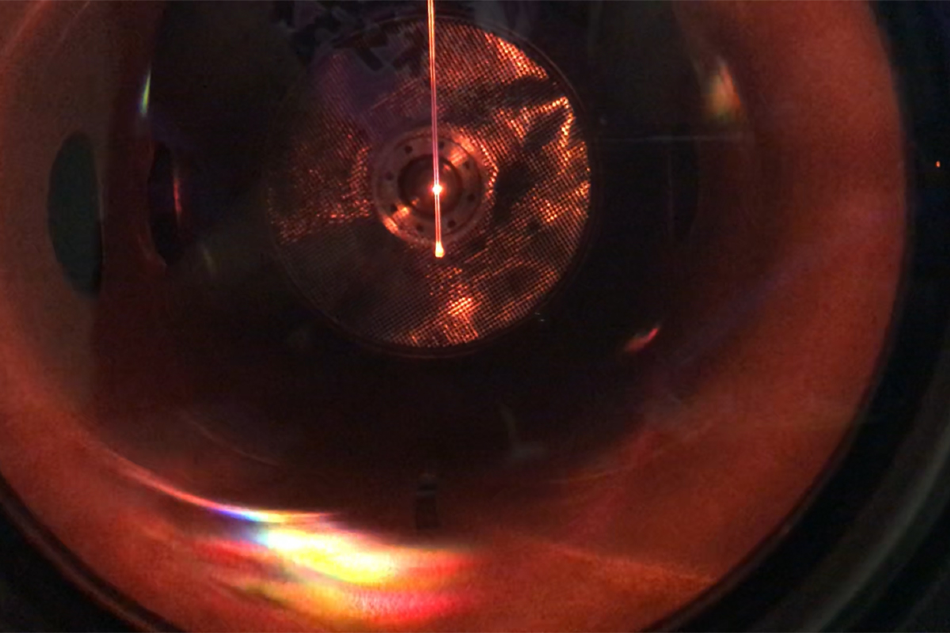Aug 24 2020
Scientists from the University of Central Florida are rendering the groundbreaking field of attosecond science more accessible to investigators from all fields of disciplines.
 A laser light shines in a gas cell where UCF researchers generate attosecond pulses. Image Credit: University of Central Florida.
A laser light shines in a gas cell where UCF researchers generate attosecond pulses. Image Credit: University of Central Florida.
Intended to help open up the field, the latest technique has been described in a study recently published in the Science Advances journal.
One billionth of a billionth of a second makes an attosecond, and the potential to make measurements with attosecond accuracy enables scientists to analyze the rapid movement of electrons within molecules and atoms at their natural time scale.
Quantifying this rapid movement can help scientists infer the underlying aspects of the interaction between light and matter, which can ultimately inform efforts to harvest Sun’s energy to detect biological and chemical weapons, carry out medical diagnostics, and for power generation, to name a few.
One of the main challenges of attosecond science is that it relies on world-class laser facilities. We are fortunate to have one here at UCF, and there are probably another dozen worldwide. But unfortunately, none of them are truly operated as ‘user facilities,’ where scientists from other fields can come in and use them for research.
Michael Chini, Study Principal Investigator and Assistant Professor, Department of Physics, University of Central Florida
According to Chini, this absence of access creates an obstacle for materials scientists, biologists, chemists, and others who could gain from using attosecond science methods on their respective fields.
Our work is a big step in the direction of making attosecond pulses more broadly accessible. We show that industrial-grade lasers, which can be purchased commercially from dozens of vendors with a price tag of around $100,000, can now be used to generate attosecond pulses.
Michael Chini, Study Principal investigator and Assistant Professor, Department of Physics, University of Central Florida
Chini added that the setup is quite easy and can be used with an extensive range of lasers with different types of parameters.
The field of attosecond science operates somewhat similar to 3D laser or sonar mapping, but at a relatively small scale. When an attosecond light pulse travels via a material, the pulse is distorted because of the communication with electrons in the material.
Quantifying such distortions enables scientists to build images of the electrons and create movies of their movement.
Generally, investigators make use of complicated laser systems, which need clean-room settings and huge laboratory facilities, as the driving lasers for the field of attosecond science.
Generating the very short light pulses required for attosecond studies—basically containing only one oscillation cycle of an electromagnetic wave—has further needed propagating the laser via tubes containing noble gases such as argon or xenon to additionally compress the pulses in time.
However, Chini’s group has designed a method to remove these few-cycle pulses from more generally available industrial-grade lasers, which could earlier create only relatively longer pulses.
The team compressed around 100-cycle pulses from the industrial-grade lasers by utilizing molecular gases, like nitrous oxide, in the tubes rather than noble gases and changing the length of the pulses sent via the gas.
The researchers added that they have demonstrated compression to just 1.6 cycles in their new study, but single-cycle pulses are within reach of the method.
According to John Beetar, the study’s lead author and a doctoral student in the Department of Physics at the University of Central Florida, the duration of the pulses and the choice of gas are crucial.
If the tube is filled with a molecular gas, and in particular a gas of linear molecules, there can be an enhanced effect due to the tendency of the molecules to align with the laser field. However, this alignment-caused enhancement is only present if the pulses are long enough to both induce the rotational alignment and experience the effect caused by it.
John Beetar, Study Lead Author and Doctoral Student, Department of Physics, University of Central Florida
Beetar continued, “The choice of gas is important since the rotational alignment time is dependent on the inertia of the molecule, and to maximize the enhancement we want this to coincide with the duration of our laser pulses.
“The reduction in complexity associated with using a commercial, industrial-grade laser could make attosecond science more approachable and could enable interdisciplinary applications by scientists with little to no laser background,” Beetar further added.
The study’s co-authors also included M. Nrisimha Murty, a distinguished postdoctoral associate in the Department of Physics at the University of Central Florida; Tran-Chau Truong, a doctoral student in the Department of Physics at the University of Central Florida; and Garima C. Nagar, a graduate student from Binghamton University.
Other authors included Yangyang Liu, a postdoctoral scholar in the Department of Physics at the University of Central Florida; Jonathan Nesper, a doctoral student in the Department of Physics at the University of Central Florida; Omar Suarez and Federico Rivas from the Central Florida Physics Research Exchange Program at the University of Central Florida.
Yi Wu, a postdoctoral researcher with joint appointments in the Department of Physics and College of Optics and Photonics at the University of Central Florida; and Bonggu Shim, an associate professor of physics, applied physics and astronomy from Binghamton University were also part of the team.
Chini received his doctorate in physics from the University of Central Florida and also received his bachelor’s in physics from McGill University. He has a secondary joint appointment in the College of Optics and Photonics at the University of Central Florida and joined the Department of Physics, which is part of the College of Sciences at the same university, in 2015.
Journal Reference:
Beetar, J. E., et al. (2020) Multioctave supercontinuum generation and frequency conversion based on rotational nonlinearity. Science Advances. doi.org/10.1126/sciadv.abb5375.